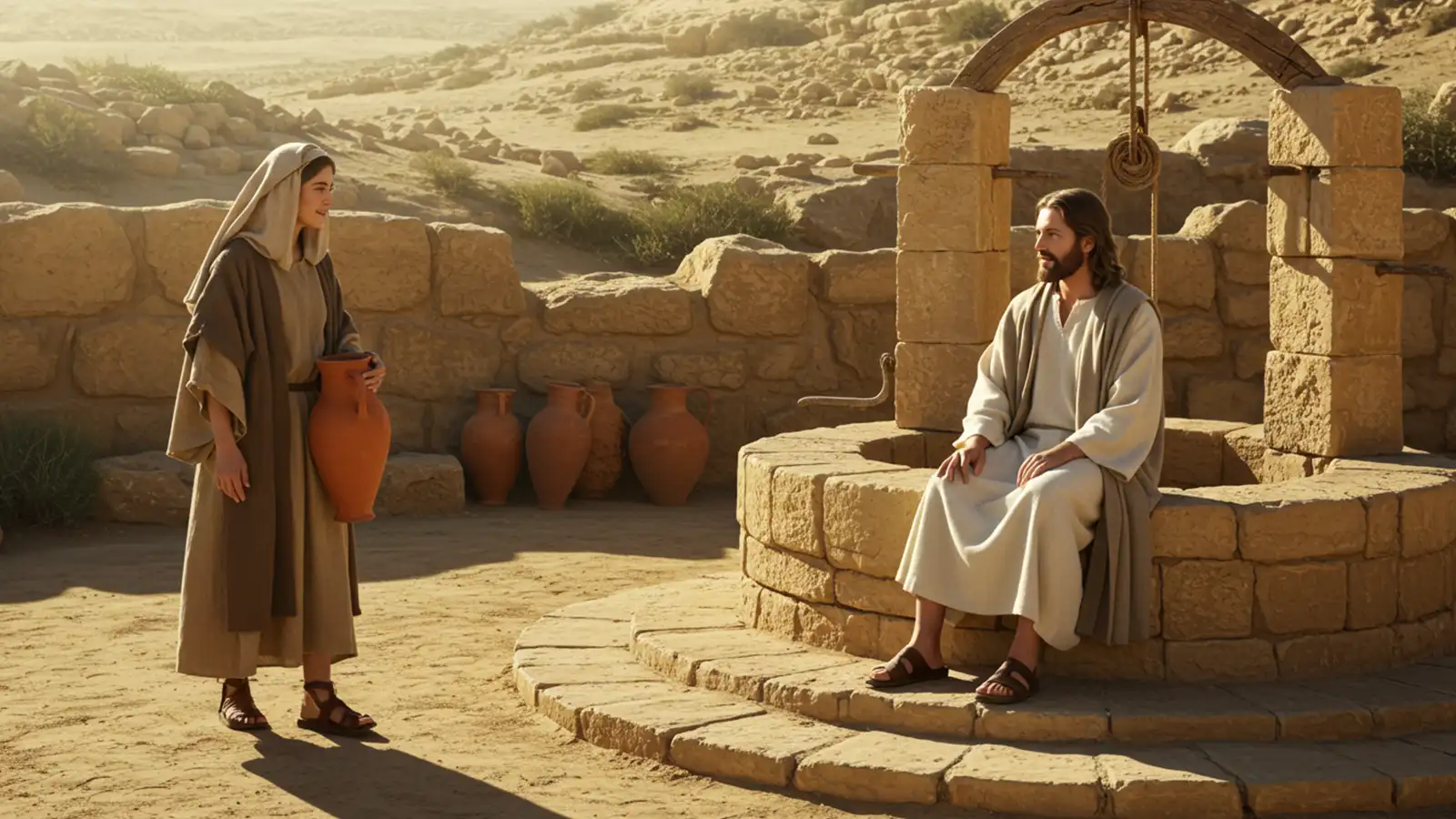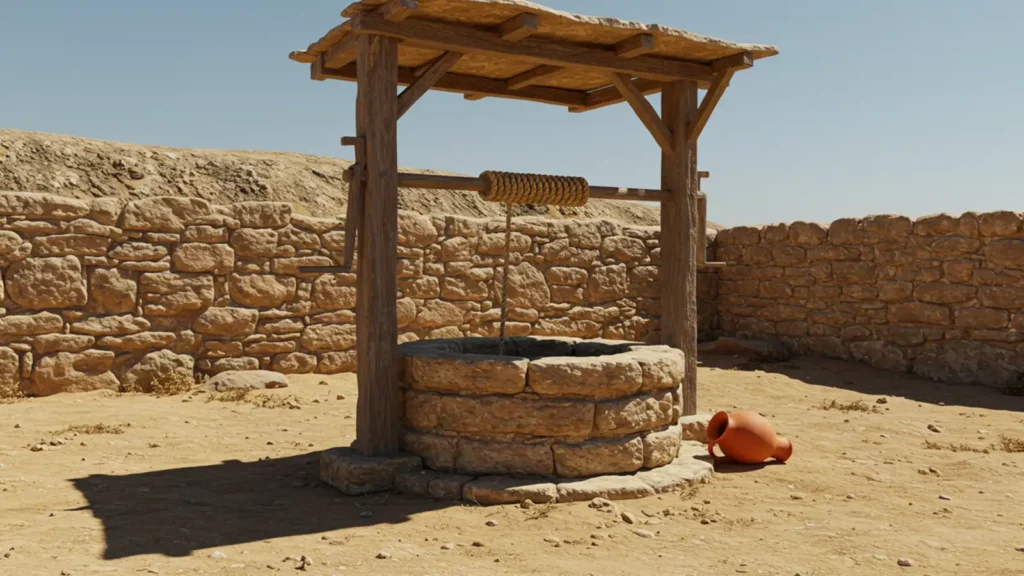The Samaritan woman is one of the most striking characters in the Gospel of John. Her encounter with Jesus, narrated in chapter 4, was not just an ordinary conversation but a true revelation about grace, forgiveness, and transformation.
Her story goes beyond a biblical episode: she became a symbol of overcoming social, religious, and personal barriers. As we dive into this narrative, we find teachings that remain alive and relevant to this day.
The Setting of the Encounter
Jacob’s Well
The episode takes place at Jacob’s well, located in Sychar, Samaritan territory. This place was steeped in tradition and history for the people of the region.
Jesus, tired from the journey, sat by the well at noon. This detail about the time is not insignificant: normally, women went to draw water early in the morning or late in the afternoon.
The Samaritan woman chose the hottest time of day, likely to avoid judgmental looks or comments from her community.
Jesus’ Request
Jesus begins the dialogue with a simple sentence: “Give me a drink.”
This request breaks taboos:
- A Jew did not usually speak with Samaritans.
- A man—let alone a teacher—did not converse in public with an unfamiliar woman.
This opening shows how much Jesus valued people beyond the social rules of his time.
Who Was the Samaritan Woman?
The Samaritan woman did not have her name recorded in Scripture, but her story reveals striking traits:
- She was a Samaritan, belonging to a people rejected by the Jews.
- Her life was marked by failed relationships: she had already had five husbands and was living with a man who was not her husband.
- She likely carried marks of social and emotional rejection.
Even with this past, she was chosen to receive one of Jesus’ most magnificent revelations: about “living water” and true worship.

The Context of the Samaritans
To understand the importance of the narrative, it is essential to remember who the Samaritans were.
- They were descendants of Jews mixed with foreigners after the Assyrian invasion.
- They had their own version of the Law and worshiped God on Mount Gerizim rather than in Jerusalem.
- Jews and Samaritans maintained a strong rivalry, avoiding contact with one another.
The Samaritan woman’s encounter with Jesus broke these barriers, showing that the message of the gospel was universal.
The Transformative Dialogue
The Living Water
Jesus presents the Samaritan woman with a profound spiritual concept: living water.
While she was thinking only of the water from the well, Jesus revealed that there was a source capable of quenching the heart’s eternal thirst.
This metaphor carries three main meanings:
- The salvation offered by God.
- The presence of the Holy Spirit as a constant source.
- Spiritual fullness that replaces fleeting pursuits.
Truth Revealed
When Jesus exposed the personal life of the Samaritan woman, she recognized that she was not standing before an ordinary man. The revelation of her relationships showed that Jesus knew her story completely.
This moment did not have a tone of condemnation but of liberation. Instead of withdrawing, she opened herself to the message.
The Identity of the Messiah
In response to her expectation about the Messiah, Jesus declared: “I am.”
It was a clear and direct revelation of his identity—something that did not always happen in other situations.
Scene Portraying the Conversation with the Samaritan Woman
The Transformation of the Samaritan Woman
The Abandoned Water Jar
After the conversation, the Samaritan woman left her jar and ran to the city. This detail carries symbolism: she left behind what represented her daily search to embrace a new spiritual mission.
The First Testimony
She became the first Samaritan missionary, leading the people of her city to meet Jesus. Her testimony was so impactful that many came to believe because of her.
Spiritual Lessons from the Samaritan Woman
The narrative of the Samaritan woman leaves us with practical and spiritual lessons.
Breaking Barriers
Jesus showed that the gospel surpasses cultural, social, and religious prejudices.
The Value of Testimony
Even without preparation, the Samaritan woman shared her experience and led many to Christ.
True Satisfaction
Spiritual thirst is not resolved with momentary pleasures but with the presence of God.
Worship in Spirit and Truth
Jesus taught that true worship does not depend on places but on a sincere heart.
The Samaritan Woman in Church History
Over the centuries, the figure of the Samaritan woman has been remembered as an example of spontaneous evangelization.
In Christian Tradition
Some ancient records even give her the name Photina, and there are traditions that consider her a martyr of the faith.
In Art and Literature
The scene at the well has inspired paintings, songs, poems, and reflections. In many depictions, the Samaritan woman appears leaving the jar, a symbol of transformation.

The Samaritan Woman and the Gospel of John
The Gospel of John is filled with transformative personal encounters: Nicodemus, the man born blind, Mary Magdalene.
Among them, the dialogue with the Samaritan woman stands out for:
- The theological depth (living water, worship, Messiah).
- The missionary reach (testimony to the city).
- The spiritual symbolism (from the well to the eternal fountain).
Frequently Asked Questions about the Samaritan Woman
Who was the Samaritan woman?
A character in the Gospel of John who had a transformative encounter with Jesus at Jacob’s well.
What does “living water” mean?
It represents the salvation and eternal life that Jesus offers.
Why was this encounter so important?
Because it showed that Jesus’ message was for everyone, including those who were socially rejected.
What is the main lesson we learn?
That only Christ can quench the true thirst of the human heart.
Bible Verses Related to the Samaritan Woman
- John 4:7 – Jesus’ request: “Give me a drink.”
- John 4:14 – “Whoever drinks of the water that I will give him will never thirst.”
- John 4:24 – “God is spirit, and those who worship him must worship in spirit and truth.”
- Isaiah 12:3 – “With joy you will draw water from the wells of salvation.”
- Jeremiah 2:13 – “They have forsaken me, the fountain of living waters.”
Conclusion
The story of the Samaritan woman is more than a biblical account. It is an invitation to transformation, welcome, and true worship.
Her encounter with Jesus shows us that no matter the past or the barriers imposed by society: everyone can drink the living water and experience the fullness of life in God.
READ ALSO:
- Good Morning Thursday Reflection: 40 Beautiful Messages
- Father’s Day Verse: Celebrate This Date with Love
- Prayer of Saint Francis of Assisi – The Most Beautiful
- Psalm 150: Final Praise and Celebration of God’s Greatness
FOLLOW US ON FACEBOOK
“`